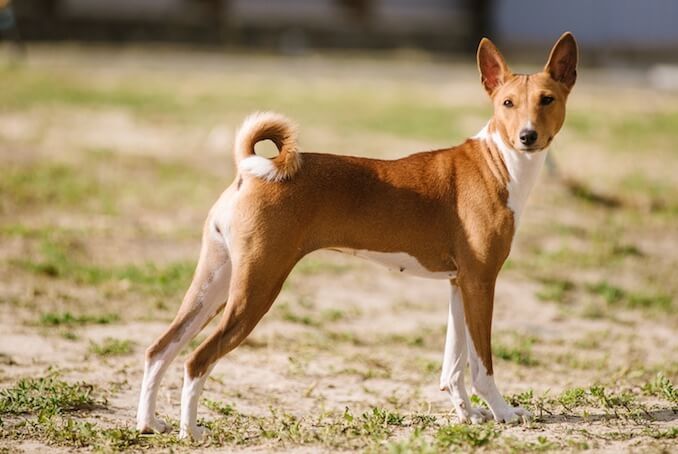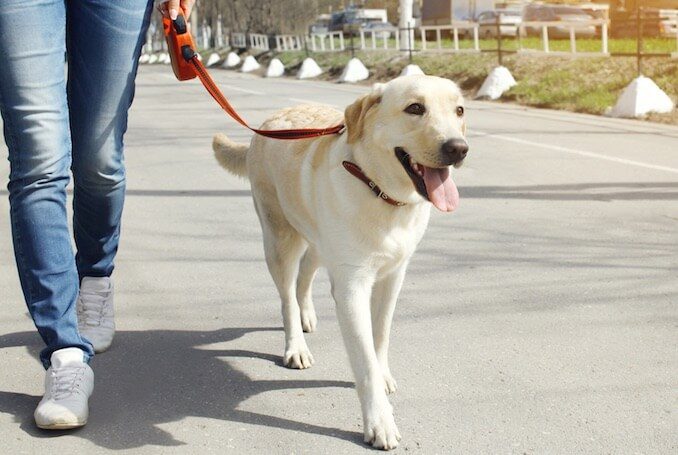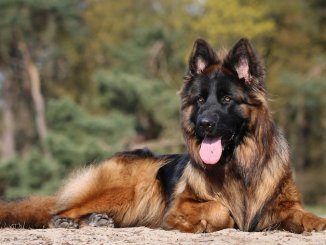
Generally, from around the age of 6 months old, a female dog will experience her first heat cycle (when she reaches puberty).
During this heat cycle (i.e. estrous) there are four distinct phases, one of which is the estrus phase. During this phase she can become pregnant and this is when she will be “in heat”.
This cycle will continue for the rest of her life, unless she is spayed.
In this article we will explore the four stages of the estrous cycle and the symptoms associated with each stage.
We will also consider the health concerns associated with heat cycles and whether you can stop your dog coming into heat.
TABLE OF CONTENTS
- Your Dog's Heat Cycle
- Quick Summary of Heat Cycle Phases
- Dog Heat Cycle Phases (Non Pregnant Dogs)
- Typical Estrous (i.e. Heat) Cycle for Pregnant Dogs
- Is My Dog in Heat? Signs and Symptoms to Watch Out For
- How to Care for a Female Dog in Heat
- Can I Prevent my Dog from Going into Heat?
- Reproductive Hormones 101
- Summary
Your Dog’s Heat Cycle

What is it? Reproduction in Dogs
Estrus, or heat, is all part and parcel of a female dog’s reproductive cycle (i.e. estrous cycle). It is one part of the four stage cycle where she becomes fertile and receptive to mating with males:
- Proestrus
- Estrus
- Diestrus
- Anestrus

When Will My Dog Have Her First Estrus Cycle?
Your unspayed female will have her first Estrus cycle when she is fully matured. This of course varies from breed to breed. It can range from 6 to 24 months of age.
Smaller breeds tend to mature a lot younger than larger breeds. For example, Morkies are defined as mature at 1 year of age, whereas a Sheepadoodle, who is larger, isn’t defined as mature until the age of 2.
Most females will have a biannual estrus, meaning they will come into heat twice a year. However, it is not cause for concern if your smaller breed has 3-4 heat cycles per year, or your larger breed only one.
Their first heat will usually be very quiet and show less signs due to the hormone levels being lower than an adult dog. This indicates they have reached sexual maturity.
Top-Tip
Never breed during 1st or 2nd heat cycle. There are two main reasons for why a female dog should never be bred during her first two heats; physiological and physiologically. Females who are bred too early show unpredictable and erratic behavior during and after pregnancy.
To understand what happens when your dog is in heat, we will now explore the four phases of the estrous cycle in more detail.
Quick Summary of Heat Cycle Phases
How often do they go into heat?
Most dogs will come into heat twice a year. But, it has been known for smaller breeds to have 3-4 heat cycles per year and larger breeds to only have one. Any concerns regarding how often your dog is coming into heat, pop to see your veterinarian.
How long do they stay in heat?
| Proestrus | 9 days | Bloody discharge, Swollen vulva and Frequent licking of genitalia |
| Estrus | 9 days | Receptive to males, Actively seeking males and Straw like discharge |
| Diestrus/Metestrus | 2-3 months | Rejecting male attention |
| Anestrus | 3-5 months | Vulva returns to normal, No discharge and No interest in males |
When does a heat cycle stop for a female dog?
An unspayed female dog will be fertile for her whole life. There is no menopause for dogs! The only way to prevent a heat cycle is to have her spayed. We’ll discuss that in more detail later in this article.
Dog Heat Cycle Phases (Non Pregnant Dogs)

Proestrus – The First Phase

On average this stage lasts for 9 days, but, it has been reported to last for anywhere between 3-27 days. The most reliable indicator of the start of this phase is vaginal hemorrhaging (bloody discharge).
Other symptoms in this phase include:
- Swelling of the vulva
- Showing increased interest in their genitalia, for example, frequent licking
- You may also notice that she is urinating more frequently.
A male will show interest in this phase as the female is secreting male attracting pheromones, but the female will not allow mounting or mating.
It is during this phase, the follicle stimulating hormone (FSH) and luteinizing hormone (LH), which are secreted by the pituitary gland, stimulate growth of follicles in the ovaries. Levels of estrogen also rise.
If you are unsure about reproductive hormones, then jump to our quick guide below.
Estrus / Standing Heat – The Second Phase

On average, this phase lasts 9 days, just like the previous Proestrus phase. However, it has been known to last from anywhere between 3-29 days!
Here the swollen vulva is less noticeable, but the bloody discharge may continue. It is more common to notice a straw like colored discharge.
Her estrogen levels will drop but progesterone levels increase. Ovulation (i.e release of an egg) occurs due to a surge in luteinizing hormone.
Larger breeds will tend to release more eggs than smaller breeds and they remain viable for 12-72 hours.
In short this is when your dog is fertile, so care should be taken to avoid unwanted pregnancies. For example:
- Ensure she is kept on leash when out on a walk
- Make sure not to leave her unsupervised when out

Diestrus / Metestrus – The Third Phase

There is some disagreement over how long this phase lasts. But, it is generally accepted anywhere between 2-3 months. In this phase, the female is obviously rejecting any male attention. If the female has been bred successfully during estrus, it is this phase that is the start of pregnancy, but we’ll come back to that a little later in this article.
Here progesterone levels are higher; slowly returning to basal levels at the end of the phase.
You may have also heard about phantom or false pregnancies? It is towards the end of this phase that they occur, due to the lowering levels of progesterone. This in turn increases levels of prolactin which causes lactation and maternal behavior. False pregnancies are common in dogs and is usually just a sign that they ovulated; not a sign of reproductive issues!
Anestrus – The Fourth Phase

This is the transition phase between one cycle and the next. It has been documented to last anywhere between 1 and 9 months. But generally expected between the 3 and 5 month mark!
Here, the female is much calmer, showing no interest in males. Her vulva is no longer swollen, there is no discharge. Her ovaries are inactive too.
We’ve considered the estrous cycle of a non-pregnant female. It is worth noting the differences when a dog becomes pregnant.
Typical Estrous (i.e. Heat) Cycle for Pregnant Dogs

So what’s the difference for a dog during their heat cycle if they are pregnant? It all changes during the 3rd phase (i.e. diestrus).
If a female has been mated during estrus, (the 2nd phase of the Estrous cycle), pregnancy occurs during the diestrus phase (the 3rd phase). As with a non-pregnant female, the pregnant female will be rejecting of male advances.
Pregnancy or gestation is defined as the length of time from mating to parturition (giving birth).
The diestrus phase in a pregnant female typically lasts 58-63 days – in short, there will be about 2 months until those puppies are born!
Signs and symptoms to watch out for in a pregnant female:
- Loss of appetite
- Vomiting
- Enlarging abdomen
- Enlarging mammary glands
- Nesting behaviour
- Irritability
Once the female has given birth, she will enter anestrus in order to recover. Her body will be getting ready for her next cycle!
Is My Dog in Heat? Signs and Symptoms to Watch Out For
We have discussed some of the physical symptoms of when an unspayed female is in heat. You will notice:
- Swollen vulva
- Bloody discharge
- Frequent urinating
- Licking genitalia
Due to the change in hormone levels, you may also notice behavioral changes.
Your dog may become more agitated or nervous, she may seem moody or withdrawn. She may also become snappy towards males during proestrus. You may see a change in appetite, this varies from dog to dog.
Not all female dogs will show the bloody discharge signaling the start of proestrus. In order to establish the fertility of your dog, it is possible to carry out certain tests.
Vaginal Smear Test
Vaginal Cytocology is where vaginal cells are taken, stained and placed under a microscope. Due to the change in hormones throughout the estrous cycle, the cells present very differently. Through identifying the differences, it is possible to establish whether or not the female is fertile. A canine fertility test some may say.
Serum Progesterone Test
A blood test can be carried out which measures levels of progesterone. We know that progesterone levels increase around ovulation, therefore based on the results, it is possible to indicate where in her cycle the female is.
So we know what happens during a heat cycle and the symptoms to be aware of. You should also be aware of what can go wrong and when there is cause for concern.
How to Care for a Female Dog in Heat

| Silent Heat | The heat is completely undetectable to humans. The dog does not present with the typical bloody discharge or associated symptoms. | Younger dogs have lower levels of hormones than adult dogs, therefore the heat presents as quieter. Tests may be carried out to establish where in the cycle your dog is. |
| Split Heat | The dog starts her heat, stops for a few days, continues and then it ceases. | Generally due to low LH levels |
| Prolonged Heat | A heat cycle longer than 21 days. | Hormone imbalance, usually persistent elevated estrogen levels. Often caused by cysts or tumor. Sometimes associated with liver issues as the metabolism of estrogen is reduced. |
Certain drugs may induce anestrus which can alter the length of a cycle. These include; anabolic drugs, androgens, glucocorticoids and progestogens. These drugs are often used to enhance performance of working and show dogs.
There are also a number of health conditions associated with irregular heats:
- Hypothyroidism – this is when the thyroid glands aren’t producing enough hormones, having a detrimental effect on the reproductive system.
- Renal failure – Estrogen serves as a protective factor to the kidneys. Low estrogen levels therefore impact on kidney function.
- Hypercorticism – Cushing’s Disease – This is when the adrenal glands produce too much cortisol; usually caused by pituitary or adrenal tumors.
If you are concerned that your dog’s cycle is irregular, seek veterinarian advice.
Can I Prevent my Dog from Going into Heat?

We’ve already established that a dog is fertile for her whole life. They don’t go through the menopause. The only way to stop a dog going into heat is to have her spayed or as some call it, desexed.
General guidance states that all dogs should be spayed/neutered if they are not being used for breeding purposes. Firstly, to prevent unwanted puppies and secondly to prevent future potential health issues such as pyometra and cancer.
What is spaying?
Spaying is the surgical removal of the ovaries, or both the uterus and ovaries.
What are the benefits?
Spaying your dog, if you aren’t intending to breed, is good for you, your pet and the community.
- Spayed dogs live a much longer and healthier life.
- Female dogs can often cry in heat and show nervous behavior.
- Unaltered dogs can display temperament problems.
When can my dog be spayed?
It is generally accepted that females can be spayed around 6 months of age. However, the arguments for allowing the female to have one heat cycle before they are spayed. Especially in larger breeds, dogs who are more prone to urinary tract infections or incontinence and those dogs who have a history of vulval dermatitis.
It is also possible for a veterinarian to suppress estrus for no longer than a 24 month period through the administration of certain medications, yet this does have its side effects including: pyometra, obesity and neoplasia of the uterus and mammary glands.
Reproductive Hormones 101
Follicle Stimulating Hormone (FSH)
- Follicle Stimulating Hormone is one of the gonadotrophic hormones. It is produced by the pituitary gland and regulates the function of the ovaries and testes. In female dogs it stimulates the growth of ovarian follicles for ovulation.
Luteinizing Hormone (LH)
- Luteinizing hormone is also one of the gonadotrophic hormones. It is the surge of LH that matures the ovarian follicles during ovulation. LH also stimulates the production of progesterone, which we know is required to support the early stages of pregnancy.
Estrogen
- Estrogen is secreted primarily from the ovaries, but can also be secreted from the adrenal glands and the placenta towards the end of pregnancy.
- Estrogen levels are at their highest during an unspayed female’s estrus cycle. It contributes to the growth and maturation of ovarian follicles and also to the release of eggs.
Progesterone
- Progesterone is a hormone released by the ovaries. It is essential in maintaining pregnancies in dogs.
- Progesterone is produced in large amounts around ovulation and continues to rise into the first half of diestrus whether or not the female is pregnant. All breeds of dogs, no matter what size, will ovulate at the same level of progesterone!
Summary
Your female dog will be fertile for her whole life, providing she doesn’t have any health concerns which affects her reproductive system.
Her estrous cycle has four distinct phases;
- Proestrus
- Estrus
- Diestrus
- Anestrus
Proestrus is signaled by the bloody discharge and frequent cleaning of her genitalia. When she is in Estrus she is at her most fertile time, this is when breeding dogs would be mated.
To avoid unwanted pregnancies, females in estrus should be closely supervised and walked on leash. Diestrus is when pregnancy occurs in the mated female, or in the unmated female, you will often see or hear about phantom or false pregnancies. Anestrus is the quieter phase, where she is getting ready for her next cycle.
There are instances when a female may have an abnormal heat, usually as a result of other heath issues affecting hormone production. The only way to stop your female coming into heat is to have her spayed by a qualified veterinarian. This also reduces the risk of pyometra and certain cancers.
If you have any concerns about your dog’s cycle or reproductive system, you should seek veterinarian advice.




I have a Caucasian which came into heat in August 2019, I expected by February 2020 she should have another heat. Alas, no sign of heat till date. Please what could be the problem?
How old is she? Has she been pretty regular with her heats previously? What is her behavior like otherwise? Some large breeds can only cycle once per year and this is deemed normal. If you are concerned, it could be worth popping a call into your Veterinarian to seek their advice; they will know her cycle history and whether it’s anything to warrant further investigation.